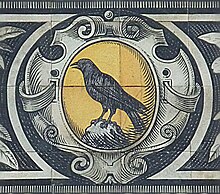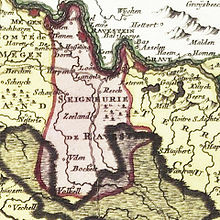Ravenstein reign

The rule Ravenstein (also Land von Ravenstein ) was a historical territory in the Holy Roman Empire , which became part of today's Netherlands at the beginning of the 19th century . The main places were Ravenstein and Uden . The northern border of the rule was the Meuse . The Duchy of Brabant (later State of Brabant) was to the west and south , while it bordered the Cuijk rule in the east .
history
The origin of the Ravenstein rule lay in the village of Herpen, which is now part of Oss . In the High Middle Ages , Herpen developed into a center of power along the Maas, from which the Herpen rule emerged. Around 1150, the lords of Cuijk owned this rule. When the Lords of Valkenburg took possession of Herpen in the 14th century , Walram van Valkenburg donated Ravenstein Castle on the Maas in 1360 in order to ensure the collection of the duties levied by him when crossing and driving on the Maas. Over time, the town of Ravenstein, which was granted town charter in 1380, developed around this castle . The central function of the rule shifted from Herpen to Ravenstein. The main place of jurisdiction was in Ravenstein. In addition, the rule was divided into two jurisdictions, the Maaskantgericht , responsible for the villages Demen, Dennenburg, Deursen, Herpen, Huisseling, Langel, Reek, Schaijk and Velp with Ravenstein as the place of jurisdiction, and the Heikantsgericht , responsible for the villages of Uden, Zeeland , Volkel and Boekel with Uden as the court. Uden was the most populous village in the Ravenstein rule.
In the Battle of Kleverhamm in 1397, the Lord of Ravenstein, Simon von Salm, an ally of Duke Wilhelm von Berg , was captured by Count Adolf von Kleve , with the result that the rule of Ravenstein was incorporated into the County of Kleve .
In the wake of the Jülich-Klevian succession dispute, troops of the States General occupied the city and the rule of Ravenstein in 1621 . In 1624 the area was added to the Protestant Brandenburg-Prussia , but in 1630 it came to the Catholic Duchy of Palatinate-Neuburg , although Brandenburg-Prussia did not give up its claim. After the troops of the generals had previously left the city, they returned in 1635 and reoccupied the rule. In 1641 a garrison church was built especially for the Protestant troops. Subsequently, work began on building Ravenstein into a fortress . However, Ravenstein was not integrated into the Republic of the Seven United Provinces , so that religious freedom prevailed in the rule and this became a refuge for Catholic religious orders in the United Netherlands . At the same time, Catholics who were resident near the border were able to attend the mass on the Ravenstein property.
Brandenburg-Prussia renounced its claim in 1671, and when a French army approached in the course of the war between France and the United Netherlands in 1672 , the troops of the generals land finally withdrew from the rule of Ravenstein, whereupon the fortress was razed, only the City gates and the castle were spared.
In Ravenstein, the only baroque church in the Netherlands outside Limburg was built in 1735 with a church consecrated to Saint Lucia . In 1743 a grammar school was built in Uden , as was also in Ravenstein in 1752, where Jesuits founded the grammar school Aloysianum. At the same time, the Ravenstein rulership suffered from roving bands of robbers who were regularly hunted down, but mostly unsuccessfully.
After the Dukes of Pfalz-Neuburg died out in 1742, the rule of Ravenstein fell to the Palatinate-Sulzbach family . In the course of the First Coalition War , troops of the French Republic occupied Ravenstein in 1794. A year later, the Ravenstein estate was sold to the Batavian Republic .
In the course of the Reichsdeputationshauptschluss conclusion on February 25, 1803, the Electorate of Bavaria, as the successor to the dukes of Pfalz-Sulzbach, renounced all claims to the rule of Ravenstein. The former rule of Ravenstein became part of the newly founded Kingdom of Holland in 1805 and the French department Bouches-du-Rhin in 1810 . In 1815, the area of the former Ravenstein rule was officially incorporated into the newly founded Dutch province of Noord-Brabant in the United Kingdom of the Netherlands and divided into ten independent municipalities.
Ravenstein Castle was demolished in 1818 at the instigation of the Dutch government.
See also
List of the rulers of the Ravenstein rule



